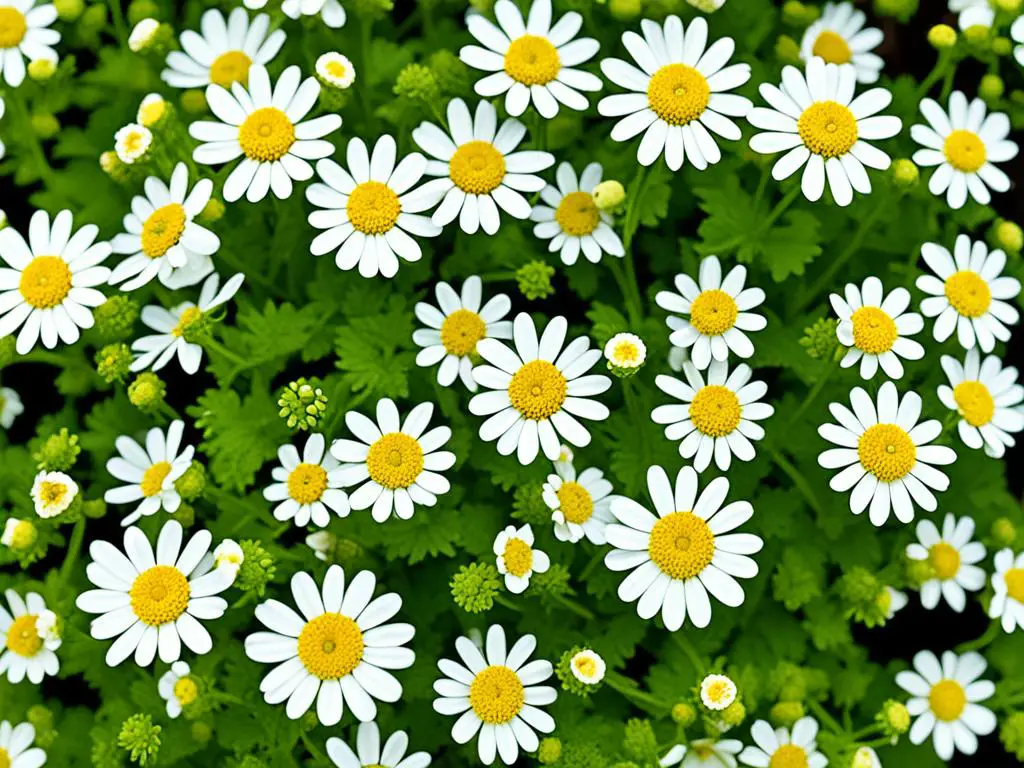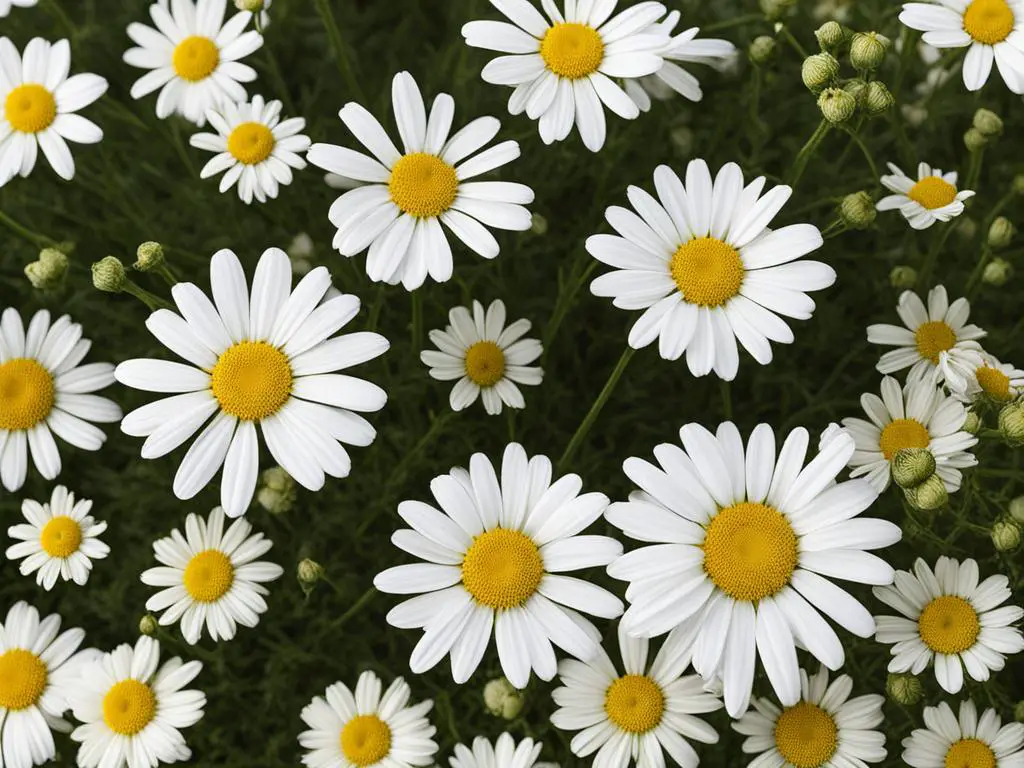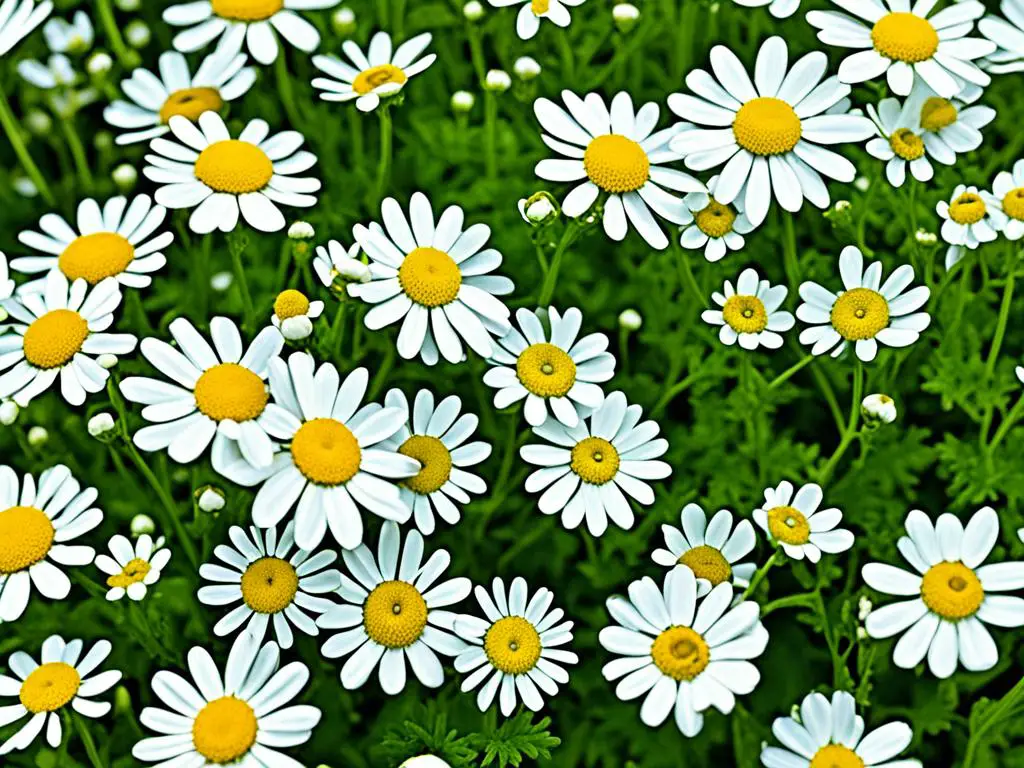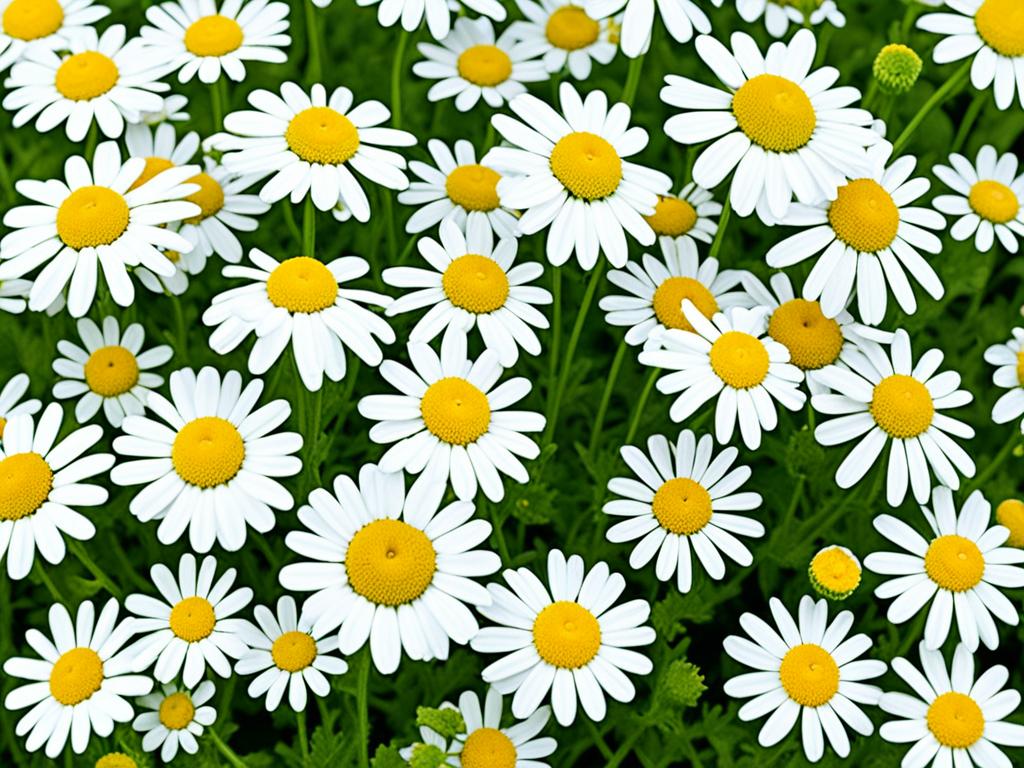Confused between chamomile and feverfew plants? Don’t worry, we’ve got you covered! In this guide, we will help you identify and differentiate between these two medicinal herbs. While they may look similar, they have unique characteristics that set them apart. So let’s dive in and explore the world of chamomile and feverfew!
Key Takeaways:
- Chamomile and feverfew are often confused due to their similar appearance.
- Both herbs have distinct characteristics that can help with identification.
- Feverfew is a perennial plant with yellowish flowers, while chamomile is an annual plant with white flowers.
- Feverfew is used for pain relief, while chamomile is known for its calming effects.
- Despite their differences, both herbs belong to the Asteraceae family and have similar care requirements.
Characteristics of Feverfew
Feverfew is an ancient medicinal plant that has been cultivated for over 2000 years. It belongs to the Tanacetum parthenium species and is known for its medicinal properties.
Feverfew originated in southeastern Europe and the eastern Mediterranean but has spread to various parts of the world. It is a perennial plant that grows up to 80 cm tall and has distinctive yellowish flowers.
When it comes to identifying feverfew, it is important to note that it should not be confused with other similar plants like German chamomile and ox-eye daisy.

| Characteristics of Feverfew | |
|---|---|
| Species | Tanacetum parthenium |
| Origin | Southeastern Europe and the eastern Mediterranean |
| Height | Up to 80 cm |
| Flower color | Yellowish |
Feverfew is a fascinating plant with a rich history and distinctive characteristics that set it apart from other herbs. Its unique properties make it a valuable addition to any medicinal herb garden.
Characteristics of Chamomile
Chamomile is another well-known medicinal herb that has been used for centuries. It belongs to the Matricaria chamomilla species and is commonly referred to as German chamomile or wild chamomile.
Chamomile is an annual plant that grows to about 24 inches. It has delicate white flowers with a yellow center and emits a sweet aroma.
Native to Europe and Western Asia, chamomile can now be found in many parts of the world. It is highly sought after for its calming properties and is often used in herbal teas and skincare products.

Chamomile is famous for its soothing effects and is commonly used to promote relaxation and relieve stress. It is also known for its anti-inflammatory and antioxidant properties.
Differences between Feverfew and Chamomile
While feverfew and chamomile may have similar-looking flowers, there are several key differences between the two.
- Feverfew is a perennial plant, while chamomile is an annual.
- Feverfew has a citrusy scent and a bitter taste, while chamomile has a sweet apple blossom aroma and taste.
- Medicinally, feverfew is used for pain relief and inflammation, particularly for migraines, while chamomile is known for its calming effects and is often used as a sleep aid.
- Additionally, feverfew can be more difficult to find and is usually more expensive compared to chamomile.
These differences in characteristics, scent, taste, and medicinal uses make it relatively easy to distinguish between feverfew and chamomile.
To further illustrate the differences between feverfew and chamomile, the table below summarizes the key contrasting features of these two herbal plants:
| Characteristic | Feverfew | Chamomile |
|---|---|---|
| Plant Type | Perennial | Annual |
| Scent | Citrusy | Sweet apple blossom |
| Taste | Bitter | Sweet |
| Medicinal Uses | Pain relief, inflammation | Calming, sleep aid |
| Availability | More difficult to find, expensive | Widely available, affordable |
By understanding these differences, you can easily identify and choose the right herb for your specific needs and preferences.
Similarities between Feverfew and Chamomile
Despite their differences, feverfew and chamomile share some similarities. Both herbs belong to the Asteraceae family and have similar-looking flowers with white petals and a yellow center. They both prefer full sun to partial sun and have similar light requirements.
- Both feverfew and chamomile require well-draining soil and regular watering.
- Both herbs are self-seeding plants, allowing them to propagate easily.
In addition to their shared physical characteristics, feverfew and chamomile also have common uses in herbal medicine and aromatherapy. Both plants possess calming properties and are known for their anti-inflammatory effects.
“Feverfew and chamomile have been used for centuries as natural remedies for various ailments. Their similarities in appearance and medicinal properties make them valuable additions to any herb garden.”
Whether you are looking for a natural sleep aid or seeking relief from pain and inflammation, both feverfew and chamomile can provide benefits. Understanding the similarities between these two herbs can help you make an informed decision about which one to incorporate into your herbal remedies.

| Similarities between Feverfew and Chamomile |
|---|
| Belong to the Asteraceae family |
| Have flowers with white petals and a yellow center |
| Prefer full sun to partial sun and have similar light requirements |
| Require well-draining soil and regular watering |
| Are self-seeding plants, allowing for easy propagation |
Conclusion
In conclusion, chamomile and feverfew are two distinct medicinal herbs that can be easily differentiated once you know their unique characteristics. While they may have similar-looking flowers, their growth habits, scent, taste, and medicinal uses set them apart. Whether you are looking for pain relief or a relaxing sleep aid, knowing the differences between chamomile and feverfew will help you make the right choice for your specific needs.
FAQ
How can I differentiate between chamomile and feverfew plants?
Chamomile and feverfew plants have distinct characteristics that can help with identification. Feverfew is a perennial plant with yellowish flowers, while chamomile is an annual with delicate white flowers.
What is the origin of feverfew?
Feverfew originated in southeastern Europe and the eastern Mediterranean but can now be found in various parts of the world.
What is the origin of chamomile?
Chamomile is native to Europe and Western Asia but is now grown in many parts of the world.
What are the differences between feverfew and chamomile?
Feverfew is a perennial plant with a citrusy scent and bitter taste, commonly used for pain relief. Chamomile is an annual plant with a sweet apple blossom aroma and taste, often used for its calming effects and as a sleep aid.
What are the similarities between feverfew and chamomile?
Both feverfew and chamomile belong to the Asteraceae family, have similar-looking flowers with white petals and a yellow center, and prefer full sun to partial sun. They also require well-draining soil and regular watering, and are self-seeding plants.
Why would I choose either feverfew or chamomile?
Feverfew is commonly chosen for its pain-relieving properties, particularly for migraines. Chamomile, on the other hand, is often chosen for its calming effects and as a sleep aid.
Are feverfew and chamomile easy to find?
Chamomile is more widely available and easier to find compared to feverfew, which can be more difficult to locate and is usually more expensive.



